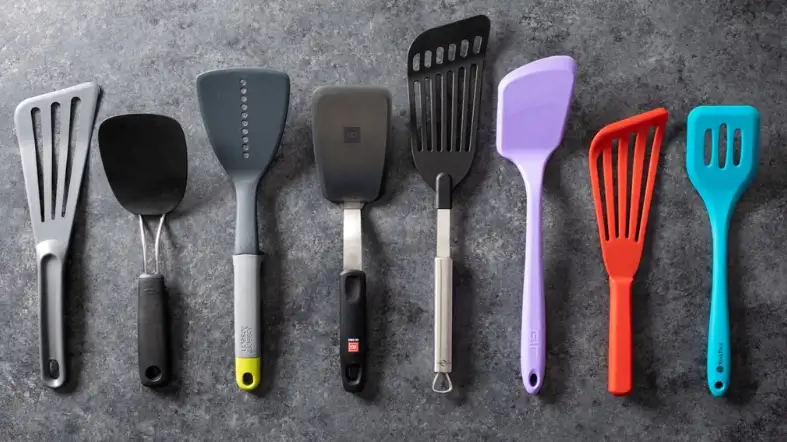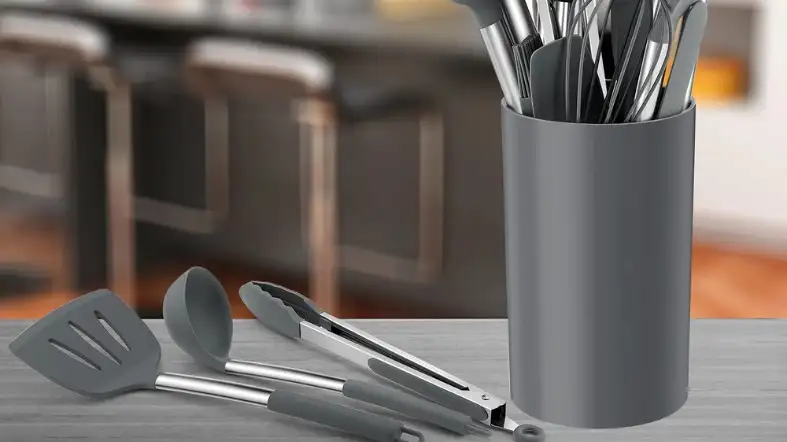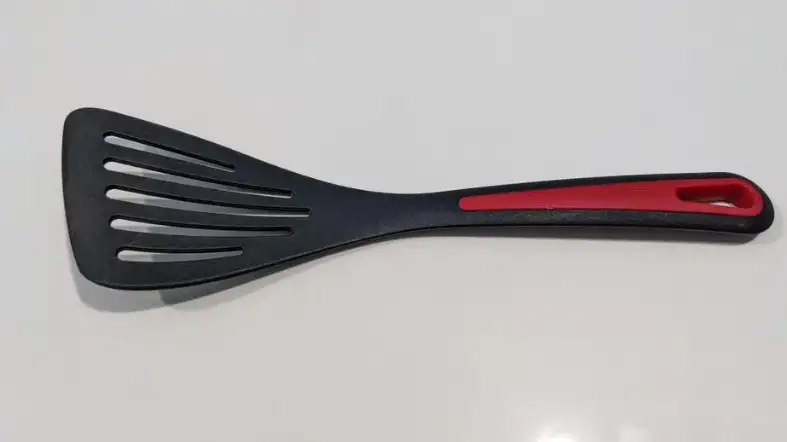Are you struggling to choose between nylon and silicone spatulas for your kitchen? If you’re unfamiliar with these materials, choosing between them can be difficult.
Nylon and silicone are popular cooking equipment, but each has its own advantages.
This article compares nylon and silicone spatulas so you can choose one for your kitchen.
As an experienced chef, I have used both materials extensively and can offer valuable insights into their performance and durability.

Nylon Vs Silicone Spatula
Nylon spatulas are heat-resistant and non-stick, making them ideal for cooking. Silicone spatulas, on the other hand, are more flexible and can withstand higher temperatures. Choose nylon for non-stick pans and silicone for high-heat cooking.
A quick comparison table between Nylon vs Silicone Spatula:
| Feature | Nylon Spatulas | Silicone Spatulas |
|---|---|---|
| Cost | Generally less expensive than silicone | More expensive than nylon |
| Durability | May need to be replaced frequently due to wear and tear | More durable and longer-lasting |
| Heat Resistance | Typically heat-resistant up to 400°F or 200°C | Can withstand higher temperatures up to 600°F or 315°C |
| Environmental Impact | Takes years to break down, less eco-friendly | Durable and better for the environment |
| Other | Generally thicker and less flexible than silicone spatulas | Softer and more flexible than nylon spatulas |
Heat resistance
Silicone spatulas are known for their high heat resistance, which makes them ideal for cooking and baking
Silicone spatulas can withstand temperatures up to 600°F, whereas nylon utensils shouldn’t be used on surfaces above 400°F unless the manufacturer states otherwise.
This makes silicone spatulas a better choice for high-heat cooking and baking tasks such as sautéing and frying.
Verdict:
If you frequently cook at high temperatures, it’s best to invest in silicone spatulas for their superior heat resistance.
Durability
Silicone spatulas are also known for their durability.
They are resistant to cracks, chips, and other forms of damage that can be caused by exposure to heat and moisture.
As a result, they tend to last longer than nylon spatulas. Silicone spatulas are safe to use and won’t scratch or damage non-stick surfaces.
Verdict:
Silicone spatulas are a durable and safe choice for all kinds of cooking and baking tasks.
Material origins

Both nylon and silicone were originally invented for non-kitchen-related purposes.
Nylon was created as a replacement for silk stockings during World War II, while silicone was invented for use in electrical insulation.
Over the years, both materials have found their way into the kitchen as cooking utensils.
Verdict:
The origins of nylon and silicone are not kitchen-related, but they have proven to be useful materials in the kitchen.
Melting point
Nylon spatulas have a lower melting point compared to silicone spatulas. According to, nylon spatulas can melt if they are frequently exposed to high temperatures.
This can be a safety hazard in the kitchen as melted nylon can release harmful chemicals.
Verdict:
Nylon spatulas are not as heat-resistant as silicone spatulas and can pose a safety risk if frequently exposed to high temperatures.
Kitchen safety
Kitchen safety is a critical consideration when choosing cooking utensils. Silicone spatulas offer more safety features than other non-metal spatulas.
They are less likely to scratch non-stick surfaces, and they are less prone to melting or releasing harmful chemicals when exposed to high temperatures.
Verdict:
Silicone spatulas are a safer option for cooking and baking tasks that involve non-stick surfaces and high temperatures.
Price differences
The price of silicone and nylon spatulas can vary depending on the brand and quality.
Silicone spatulas tend to be more expensive than nylon spatulas.
However, the durability and safety features of silicone spatulas may make them a better long-term investment.
Verdict:
Silicone spatulas may be more expensive than nylon spatulas, but they are a worthwhile investment due to their durability and safety features.
Stick resistance

Silicone spatulas are known for their stick resistance, which is why they are often recommended for use with nonstick pans.
They have a smooth surface that glides easily over food, making it easy to flip or remove delicate items without damaging the surface of the pan.
Verdict:
If you frequently use nonstick pans, a silicone spatula may be the best choice for you due to its stick resistance.
Ease of cleaning
Silicone spatulas are generally easier to clean than nylon spatulas because they don’t retain food particles or odors.
In addition, many silicone spatulas are dishwasher safe, making cleaning even more convenient.
Verdict:
If you prioritize ease of cleaning in your kitchen tools, a silicone spatula may be a better choice than a nylon spatula.
Comfort
Silicone spatulas are generally softer and more comfortable to hold than nylon spatulas.
They have a non-slip grip that makes it easier to hold onto them, even when your hands are wet or greasy.
Verdict:
If you value comfort and ease of use in your kitchen tools, a silicone spatula may be a more comfortable choice than a nylon spatula.
>> Which Spatula Is Best for Turning Fish?
Nonstick spatulas

Silicone spatulas are often recommended for use with nonstick cookware because they are less likely to scratch or damage the nonstick coating.
Nylon spatulas can be too abrasive for nonstick surfaces and may cause damage over time.
Verdict:
If you frequently use nonstick cookware, a silicone spatula may be a better choice to avoid damaging the nonstick coating.
Fish spatulas
Fish spatulas are a type of slotted spatula that is designed specifically for flipping delicate items like fish.
Both types of them usually made of stainless steel or metal, but they can also be made of silicone or nylon.
Verdict:
If you frequently cook delicate items like fish, a fish spatula may be a good addition to your kitchen tools.
Material composition
Silicone and nylon are both synthetic materials, but they have different chemical compositions.
The raw material of silicone is silicon, oxygen, carbon, and hydrogen, and other hand nylon contains carbon, oxygen, nitrogen, and hydrogen as ingredients.
Verdict:
If you are interested in the chemical composition of your kitchen tools, there are differences between silicone and nylon spatulas.
Performance
Silicone spatulas are known for their superior performance in the kitchen.
They are highly heat-resistant, making them a great option for cooking on high-temperature surfaces.
Additionally, silicone spatulas are non-stick, which means that food is less likely to get stuck to the surface.
This makes them ideal for flipping delicate items like eggs or pancakes.
Verdict:
If you’re looking for a spatula that performs well in the kitchen, a silicone spatula is likely your best bet.
Its heat resistance and non-stick properties make it a versatile and reliable tool for any home cook.
Size and shape
Spatulas come in a variety of shapes and sizes, each designed for specific cooking tasks.
For example, a slotted spatula is ideal for flipping delicate items like fish, while a wider spatula is better suited for flipping pancakes or burgers.
Additionally, some spatulas have longer handles, which can be helpful for reaching deeper pots or pans.
Verdict:
The size and shape of your spatula will depend on your specific cooking needs.
Consider the types of foods you’ll be cooking and the size of your cookware when selecting a spatula.
Flexibility
The flexibility of a spatula can impact its performance in the kitchen.
Silicone spatulas tend to be more flexible than their nylon counterparts, which can be helpful when flipping delicate items like eggs or pancakes.
However, some cooks prefer a sturdier spatula for tasks like scraping the bottom of a pan.
Verdict:
The level of flexibility you prefer in a spatula is a matter of personal preference.
Consider the types of foods you’ll be cooking and your own cooking style when selecting a spatula.
FAQs
What Is The Difference Between Nylon And Silicone Spatulas?
Nylon spatulas have a lower heat resistance compared to silicone spatulas and can melt if frequently exposed to high temperatures, usually above 400°F (204°C).
Silicone spatulas are food-grade, do not react negatively with liquids or food, and can withstand extreme temperatures up to 600°F (315°C) without melting or releasing any dangerous odors.
Which Material Is Better For Spatulas?
Silicone is generally considered to be the better material for spatulas as it is more durable, heat-resistant, and does not release any harmful substances or odors when in contact with food.
It is also easier to maintain and clean compared to nylon.
What Are Some Recommended Spatulas Made Of Nylon?
The OXO Good Grips Nylon Square Turner is a sturdy and versatile spatula that is useful on all surfaces.
However, it has a low heat resistance and should not be used on surfaces above 400°F (204°C) unless the manufacturer states otherwise.
Other recommended nylon spatulas include the Blade Hamburger Turner by Winco and the Wilton Angled Spatula.
What Are Some Recommended Spatulas Made Of Silicone?
The DI ORO Designer Series Classic Spatula is a popular choice for cooking eggs, while the Pampered Chef Stainless Steel Fish Spatula is recommended for use with cast iron.
The Anolon SureGrip Slotted Turner is best for nonstick pans, while the Wilton Angled Spatula is best for offset/icing purposes.
For a set of spatulas, the OXO 3-Piece Silicone Spatula Set is a good choice.
The Rubbermaid High Heat Silicone Spatula is also a recommended all-around spatula.
How Can I Distinguish Between Nylon And Silicone Spatulas?
One way to distinguish between nylon and silicone spatulas is to squeeze them.
Silicone is soft and rubbery, while nylon is hard and plasticky [10].
Additionally, you can check the manufacturer’s label or packaging to confirm the material used.
Conclusion
When it comes to choosing between a nylon and a silicone spatula, it ultimately comes down to personal preference and the intended use.
Nylon spatulas are great for cooking at high temperatures and are more durable, while silicone spatulas are better suited for baking and can withstand higher temperatures without melting.
Both materials offer advantages and disadvantages, so it is essential to analyze your unique requirements before making a choice.
Whether you choose a nylon or silicone spatula, it is ultimately worthwhile to invest in a high-quality utensil.
So go ahead and select the one that best suits you, and have fun cooking!
